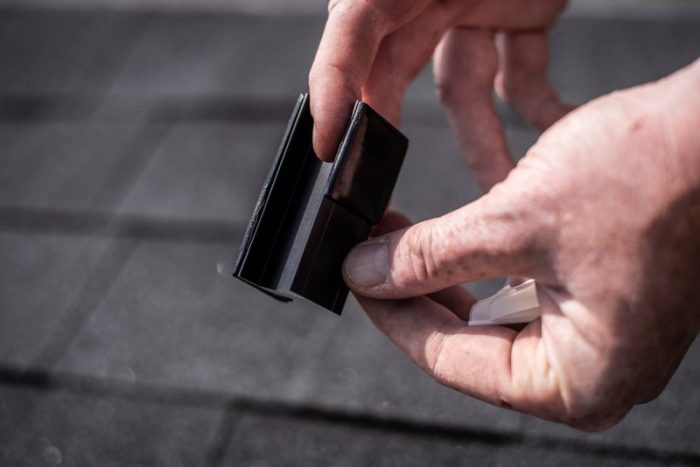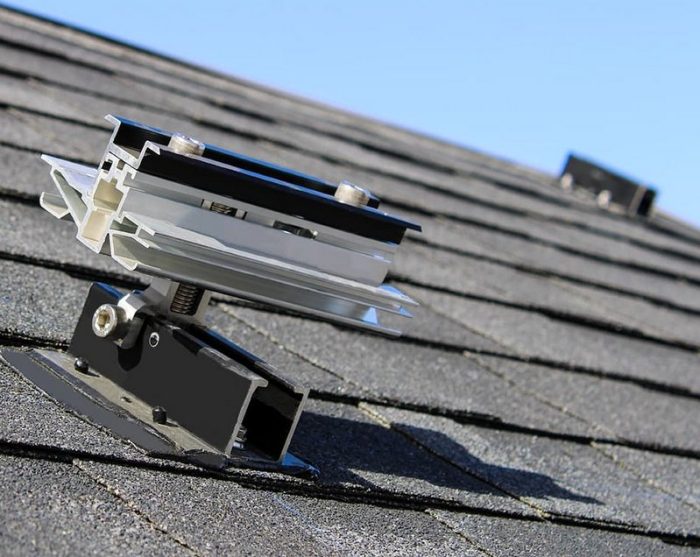Rooftop solar mounting techniques have evolved a lot over the decades. Yesterday’s best practices have a habit of becoming today’s nightmares. There was the “goop and a prayer” era, of course, which led to the metal pipe flashing era. Shoving that metal flashing underneath roof shingles introduced new problems.
Those issues with rigid metal flashing have led to a wider spread use of “flexible flashing” products — many of which are starting to utilize a butyl rubber-based solution.
In this article, we’ll go over the finer points of butyl rubber as it pertains to solar rooftop mounting solutions with Roof Tech Inc., the solar rooftop mounting manufacturer that started the trend.
Basics of butyl

Butyl rubber itself is not new. It is a stronger substance than a sealant and has been used in construction as a means of waterproofing skylights, swimming pool lining, and so on.
“This is not a sealant. This is not caulking. This is a flashing,” says Milton Nogueira, senior business development manager of Roof Tech’s butyl rubber-based product, now trademarked as AlphaSeal.
Those terms are not interchangeable. For one thing, some third-party sealants aren’t compatible with asphalt roofs and cause a chemical reaction that compromises the roof. Sealants and caulking will also degrade and crack over time in the heat vs. certain butyl formulations that carry a much higher temperature rating.
Butyl-based product variety
You can find butyl rubber products at Home Depot — however, you won’t want to use those for rooftop solar attachments. Not all butyl is chemically capable of being a leak-proof roof flashing.
“The chemical compounds that produce the end butyl product are different,” says Ken Clem with Roof Tech Inc. “Saying a ‘butyl-based product’ is like saying an ‘alcohol-based drink.’ There’s a wide variety of outcomes based on what you put in it.”
Roof Tech was the first solar mounting manufacturer to incorporate a butyl tape into its solar mount design, and it has been using the same “flavor” for decades in Japan. Nogueira and his team went to extra lengths to prove their butyl’s worth when bringing it to the U.S. a decade ago, achieving International Code Council (ICC) certification for its product as flexible flashing (ICC ESR-3575). If a butyl product does not hold an ICC rating to vouch for its flexible flashing, it may act more like a sealant.
“The butyl we have is the best for our application, and we know that because we have been putting that outside since we developed the formula in the ‘90s,” Nogueira says.
Roof Tech has conducted accelerated aging tests of its butyl-based mounts for an entire year at a constant temperature of 145 F at 50% humidity and with constant UV light. Roof Tech’s AlphaSeal is rated for 248 degrees F, which is much higher than caulking often used on a roof.
Not all butyl-based products boast the same waterproofing rating either. Clem notes that the AlphaSeal is rated for use in low and steep slope applications as well as EPDM, TPO, metal and asphalt roofs. Composite roofs are a case-by-case basis.
“Because we have an ICC evaluation report, the ICC site keeps warranty checks, and once a year they check it for quality,” Nogueira explains. “It wouldn’t pass if we used a different butyl — it must be the very same for our certification.”
On top of the lab tests, Roof Tech has had this product in the field since 1994 — which gave it the confidence and real-world results to justify extending its AlphaSeal warranty to 25 years.
Building with butyl in mind

Clem is quick to note that it’s not just the butyl formula that matters. Everything from the extrusion to the hole placement to the screws used must be specifically designed to work together.
Do not get creative.
“We met one customer who said he takes a little piece of butyl and then pairs that with a lag bolt,” he recalls. “And we had to tell him that the butyl only has a limited amount of elasticity specific to our product. If you use a lag bolt, you would tear one side and have an open gap that could cause issues over time.”
Nogueira can also tell when a seemingly comparable wood screw “won’t take the flexible flashing around in the same fashion,” he says. “Everything is designed for a reason.”
Lastly, a solar mount with butyl rubber rated as flexible flashing offers better protection against thermal expansion and contraction.
Buying a full solution
Another benefit of buying a butyl-based “self-flashing” solar mount as a single, kitted product (versus needing a third-party sealant or caulking) is single point of contact if there’s an issue or warranty claim.
“If you have an issue with a product with metal flashing under the shingle, and there’s a warranty claim all they have to do is say ‘you didn’t put the caulking on right — not my problem.’” Clem says. “Ours is peel and stick, it’s all right there and lowers the liability for the company.”
Bottom line on butyl
Not long ago, direct-to-deck solar mounts with flexible flashing were a novelty, often derided by market leaders at the time. In 2023, many new solar mounts are coming to market with butyl rubber advertised as a flexible flashing solution. Just be advised that the usual best practices (checking under the roof for structural viability and conditions) and due diligence of each product’s water proofing and temperature rating and code compliance still applies.
— Solar Builder magazine
[source: https://solarbuildermag.com/news/basics-of-butyl-for-rooftop-solar-installers/]

Leave a Reply
You must be logged in to post a comment.